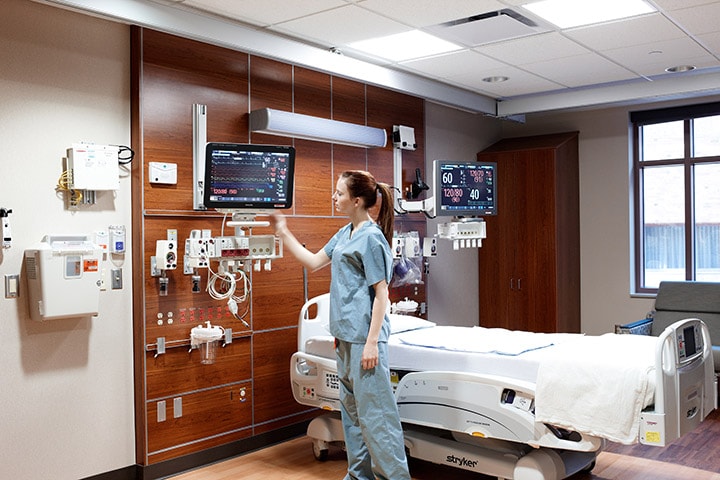The 1992 US presidential campaign is famous for, among other things, the coining of the phrase ‘It’s the economy, stupid!’ Some 30 years later, a popular cartoon by René Cattin showed Greta Thunberg writing over the word ‘economy’ and replacing it with ‘planet’. Today, we could tighten the focus even further – ‘It’s the circular economy!’ Interestingly, one of the other key messages during that same 1992 presidential campaign was … ‘Don't forget healthcare’… The combination of expanding, aging populations and the rising incidence of chronic diseases has created a pressing need for sustainable models of care delivery. This is being exacerbated by excessive levels of waste – physical and otherwise – in health systems the world over. According to Practice Greenhealth, hospitals produce 13 kg waste per bed per day, of which 15-25% is hazardous waste. At the same time, the world’s healthcare systems account for 4% of global CO₂ emissions, more than the global aviation or the shipping industry. And we now know that achieving global climate goals critically depends on more sustainable use of materials, i.e. going circular. It will come as no surprise, then, that more and more care providers are keen to hear how we can help them make responsible choices that address their sustainability ambitions, as well as their clinical and operational goals. As a health technology company, Philips is committed to making the world healthier and more sustainable through innovation, while acting responsibly towards the planet and society. It is our ambition to be a leading circular company, decoupling growth from resource consumption across the value chain – shifting from products to solutions, and maximizing value for customers, patients and planet by responsively and proactively managing the lifecycle of our solutions. Circular design is central to that endeavor.

How is Philips addressing this?
Together with our customers and suppliers we have developed a deep understanding of material flows in our industry. Based on these insights, and through our long-established EcoDesign program, we continue to optimize the design of our products and solutions to increase energy efficiency and reduce emissions and packaging. But to make circular models mainstream in healthcare, more needs to be done. To this end, we consider four key drivers:
1. Making sustainable choices right from the start
On average, 80% of a product’s total environmental impact – including energy during use and material impact – is determined in the design phase. EcoDesign, and circular design in particular, is an approach that holistically considers all aspects of product development and design. That means, from the outset of the product creation process, designing for less weight and for recycled content, as well as designing for serviceability, upgradability, modularity, recycling, parts recovery and/or refurbishment. Similarly, refurbishment of pre-owned systems enables care facilities to extend their resources within a restricted budget, without compromising on quality.
Integrated approach
Before going deeper, let us dispel a common misconception: there is no such thing as a ‘circular product’. A circular solution is always a combination of an appropriately designed product and/or service and a specific business model.
With usage- and outcome-based business models, for example, we are moving from selling the physical product or system to offering its use ‘as a service’. That way, hospitals can access the functionality of, say, high-quality imaging, analytics and informatics, without upfront capital expenditure. Models like this have the added benefit of supporting multiple re-use and recycling, thus contributing to the sustainable use of resources.

From hardware to software and services with minimum material impact The way we watch movies at home is a great example. First of all we bought DVDs, which included the DVD player and the discs – physical products. Then the business model changed, and we started to rent the DVDs. This extended the products’ life, with hundreds of people now able to access the content through the same small piece of coated polycarbonate. The real change came when the service was digitized, which meant that content could be downloaded and consumed anywhere, without specialist hardware and with no need for travel. The result? A better consumer experience and much less pollution and material usage.
In this age of digitalization, it is essential to start the design process with the possibility of ‘dematerialization’ in mind. In other words, when thinking about how to address a customer’s needs, we first ask ourselves, ‘Can we deliver (at least part of) the value our customer wants with a digital/software solution?’ After all, what gets done virtually, leaves less footprint.
2. System change and context (ecosystem) thinking
Design is evolving beyond the craft of design to encompass the entire cycle, end to end. This requires designers to think systemically. Circular design means going beyond designing an appealing, ergonomically sound product for here and now, but rather delivering a product that is kept in use for as long as possible, works effectively in the surrounding ecosystem, and can be taken back and repurposed at the end of the (initial) life cycle. For designers, this means making sure they understand the full context of use, how the product will be used, upgraded, repaired (after use), etc. Making sure it fits in with new business models of care delivery, such as Ambulatory Care Centers. And because customer needs and the context of use are constantly evolving, making sure that the product or service design has the built-in flexibility to accommodate changing requirements.

It is important to stress, however, that systemic thinking is not at the expense of people focus. Our aim is to amplify and enhance our people-centric design with due consideration for the well-being of the planet, the ultimate goal being to benefit the entire ecosystem. We can have the greatest impact, also environmentally, by keeping customer/patient needs top of mind. Continually challenging ourselves: ‘What is the optimal (care path) experience we would want to give a patient, with optimal flow through the system, delivering the care with minimal equipment? And in an environment that is least capital-intensive – after all, the more we can deliver at home, the less we need patients to visit expensive, heavy-footprint hospital environments. By way of example: at Philips, we are now able to add remote monitoring solutions into a cardiac post-acute care pathway, enabling patients to be released from hospital much sooner and significantly reducing the hospital’s carbon footprint.
3. Teaming up across the value chain
At Philips, we believe that, from the outset, circular design needs to be a discussion between all stakeholders across the end-to-end value chain – not only (product) designers, engineers and marketeers, but also business model designers, finance, production, etc. Essential to this discussion is the voice of our healthcare customers, governments and industry partners. Together with them, we leverage Design Thinking methodologies to Co-create solutions that are tailored specifically to the challenges facing our customers, as local circumstances and workflows are key ingredients in the successful implementation of solutions. In these Co-create sessions, customers often ask us for guidance: ‘How do I become a sustainable health system? How can you, as our industry partner, help us reach our regional carbon targets? I need to be resilient, how do I build back green?’ To answer these questions, and help our customers make sustainable choices, we are developing 360° sustainability assessments. These are intended to help health systems optimize patient flow management and so reduce resource usage and unnecessary waste – minimizing their environmental footprint and improving the financial bottom line. The assessments address all aspects of care: clinical, operational, technological, and patient and staff experience, for both existing/renovation and new-build healthcare environments. One example of teaming up with customers and suppliers to design a circular or ‘closed cycle’ system is our partnership with Jackson Health System for an Enterprise Monitoring as a Service (EMaaS) model. Unlike traditional business models where a hospital purchases and owns the patient care monitoring system and is responsible for ongoing upgrades across its network, this model keeps the ownership with Philips, including all current and future hardware, software, and networking solutions. The customer pays a per-patient fee.

Six months after deployment of the new EMaaS model, nursing staff gave it a 90% satisfaction rating, up from 8% prior to the new system. The hospital also estimates it will save over 13,000 staff hours from workflow improvement and automation of manual tasks. Moreover, the new patient transport process has reduced the time it takes to connect a patient to a transport monitor from 5 minutes to 3.9 seconds.
4. (Future) design workforce to secure sustainable future
In our Philips design community, we often say ‘Sustainability begins with us’. Design is one of the company functions with the widest span. Externally, it reaches from the hospital to the home. Internally, it touches almost every aspect of the business. As circular thinking becomes ‘the new normal’, a future-ready design workforce needs to be able to think – and talk the same language – across multiple disciplines. This means combining business development acumen and digital and marketing capabilities with the traditional requirement for design excellence. To expand our circular thinking, we collaborate with institutions from across the world of research and academia, and ensure that learnings are fed into our strategy and innovation processes. We have also developed an active circular design community, including 50 ‘circular champions’ acting as change agents. And looking to the future, we stimulate young talent to get involved, through initiatives like the Student Service Design Challenge and the Nudge global impact challenge.

The road ahead At Philips, we want to make sure that our decisions are the right choice for our customers, the planet, and society. Building upon our collective experience and involving others (customers, peers, new talent, suppliers and other innovation partners), we are striving to design solutions that drive impact without further depleting the Earth’s resources. With the ultimate aim of going beyond ‘impact neutral’ and driving regenerative thinking, design and innovation. Design can and should address the systemic and institutional challenges our rapidly changing world is facing. Designing products, services and experiences that improve people’s lives while respecting the planet’s limits. We can only attain these goals by collaborating with others in our ecosystem – care providers, practitioners, knowledge partners, and suppliers. Keen to learn from others’ best practices, we would love to hear more about how your organization is adopting circular thinking and design.
Circular economy and circular design allow healthcare organizations to benefit from, and contribute to, sustainable business models that help them remain resilient and achieve the Quadruple Aim – better health outcomes, improved patient and staff experience, lower cost of care.
Share on social media
Topics
Author

Robert Metzke
Philips Global Head of Sustainability Mr. Metzke leads Philips’ activities in Sustainability where he drives the company’s strategy towards innovative, sustainable business models and embedding sustainable and circular ways of working across Philips. In particular, Robert and his team are leading all activities with regards to Philips' environmental responsibility, with a focus on climate action, circular economy and expanding access to healthcare in underserved communities, as part of Philips overall purpose to improve people's health and well-being. Before joining Philips, Mr. Metzke worked at McKinsey & Company as a consultant where he gained 5 years of experience in strategy and innovation in the high-tech, healthcare and public sectors. Mr. Metzke has a background in journalism, science publishing (Science/ AAAS) and academic research (physics). He is married, has three children and lives in the Netherlands.
Follow me on

Sean Carney
Former Chief Experience Design Officer at Royal Philips from 2011 to 2022













